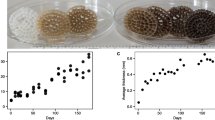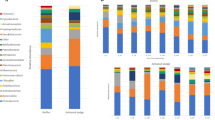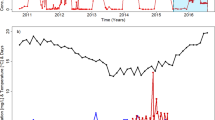Abstract
Biofilm-based technologies, such as moving bed biofilm reactor (MBBR) systems, are widely used to treat wastewater. Biofilm development is important for MBBR systems as much of the microbial biomass is retained within reactors as biofilm on suspended carriers. Little is known about this process of biofilm development and the microorganisms upon which MBBRs rely. We documented successional changes in microbial communities as biofilms established in two full-scale MBBR systems treating municipal wastewater over two seasons. 16S rRNA gene-targeted pyrosequencing and clone libraries were used to describe microbial communities. These data indicate a successional process that commences with the establishment of an aerobic community dominated by Gammaproteobacteria (up to 52 % of sequences). Over time, this community shifts towards dominance by putatively anaerobic organisms including Deltaproteobacteria and Clostridiales. Significant differences were observed between the two wastewater treatment plants (WWTPs), mostly due to a large number of sequences (up to 55 %) representing Epsilonproteobacteria (mostly Arcobacter) at one site. Archaea in young biofilms included several lineages of Euryarchaeota and Crenarchaeota. In contrast, the mature biofilm consisted entirely of Methanosarcinaceae (Euryarchaeota). This study provides new insights into the community structure of developing biofilms at full-scale WWTPs and provides the basis for optimizing MBBR start-up and operational parameters.




Similar content being viewed by others
References
Abbott BJ, Laskin A, McCoy C (1973) Growth of Acinetobacter calcoaceticus on ethanol. Appl Microbiol 25(5):787–792
Allen TD, Lawson PA, Collins MD, Falsen E, Tanner RS (2006) Cloacibacterium normanense gen. nov., sp. nov., a novel bacterium in the family Flavobacteriaceae isolated from municipal wastewater. Int J Syst Evol Microbiol 56(6):1311–1316
Altschul SF, Gish W, Miller W, Myers EW, Lipman DJ (1990) Basic local alignment search tool. J Mol Biol 215(3):403–410
Andreottola G, Foladori P, Ragazzi M, Tatàno F (2000) Experimental comparison between MBBR and activated sludge system for the treatment of municipal wastewater. Water Sci Technol 41:375–382
Aslam Z, Im W-T, Kim MK, Lee S-T (2005) Flavobacterium granuli sp. nov., isolated from granules used in a wastewater treatment plant. Int J Sys Evol Microbiol 55(2):747–751
Benedict RG, Carlson DA (1971) Aerobic heterotrophic bacteria in activated sludge. Water Res 5(11):1023–1030
Biswas K, Turner SJ (2012) Microbial community composition and dynamics of moving bed biofilm reactor systems treating municipal sewage. Appl Environ Microbiol 78(3):855–864
Boetius A, Ravenschlag K, Schubert CJ, Rickert D, Widdel F, Gieseke A, Amann R, Jorgensen BB, Witte U, Pfannkuche O (2000) A marine microbial consortium apparently mediating anaerobic oxidation of methane. Nature 407(6804):623–626
Caffoor I (2008) Energy efficient water and wastewater treatment. Business case to the Environmental Knowledge Transfer Network. Environmental KTN Publications. Available at http://www.environmental-ktn.com
Calderón K, Martín-Pascual J, Poyatos JM, Rodelas B, González-Martínez A, González-López J (2012) Comparative analysis of the bacterial diversity in a lab-scale moving bed biofilm reactor (MBBR) applied to treat urban wastewater under different operational conditions. Bioresource Technol 121:119–126
Cao CY, Zhao YH (2012) The comparison of MBBR and ASP for treatment of petrochemical wastewater. Petrol Sci Tech 30(14):1461–1467
Cao S-J, Deng C-P, Li B-Z, Dong X-Q, Yuan H-L (2010) Cloacibacterium rupense sp. nov., isolated from freshwater lake sediment. Int J Sys Evol Microbiol 60(9):2023–2026
Connaughton S, Collins G, O’Flaherty V (2006) Development of microbial community structure and activity in a high-rate anaerobic bioreactor at 18 °C. Water Res 40(5):1009–1017
Curtis T, Sloan W (2006) Towards the design of diversity: stochastic models for community assembly in wastewater treatment plants. Water Sci Technol 54(1):227–236
Delong EF (1992) Archaea in coastal marine environments. Proc Nat Acad Sci USA 89(12):5685–5689
Edgar RC, Haas BJ, Clemente JC, Quince C, Knight R (2011) UCHIME improves sensitivity and speed of chimera detection. Bioinformatics 27(16):2194–2200
Favero M, Carson L, Bond W, Petersen N (1971) Pseudomonas aeruginosa: growth in distilled water from hospitals. Science 173(3999):836–838
Fernández N, Díaz E, Amils R, Sanz J (2008) Analysis of microbial community during biofilm development in an anaerobic wastewater treatment reactor. Microb Ecol 56(1):121–132
Fu B, Liao X, Ding L, Ren H (2010) Characterization of microbial community in an aerobic moving bed biofilm reactor applied for simultaneous nitrification and denitrification. World J Microbiol Biotechnol 26:1981–1990
Gray ND, Miskin IP, Kornilova O, Curtis TP, Head IM (2002) Occurrence and activity of Archaea in aerated activated sludge wastewater treatment plants. Environ Microbiol 4(3):158–168
Hu M, Wang X, Wen X, Xia Y (2012) Microbial community structures in different wastewater treatment plants as revealed by 454-pyrosequencing analysis. Bioresource Technol 117:72–79
Inagaki F, Takai K, Nealson KH, Horikoshi K (2004) Sulfurovum lithotrophicum gen. nov., sp. nov., a novel sulfur-oxidizing chemolithoautotroph within the ε-Proteobacteria isolated from Okinawa Trough hydrothermal sediments. Int J Syst Evol Microbiol 54(5):1477–1482
Joachimiak MP, Weisman JL, May BCH (2006) JColorGrid: software for the visualization of biological measurements. BMC Bioinformatics 7(1):225
Kwon S, Kim TS, Yu GH, Jung J-H, Park H-D (2010) Bacterial community composition and diversity of a full-scale integrated fixed-film activated sludge system as investigated by pyrosequencing. J Microbiol Biotechnol 20(12):1717–1723
Labelle MA, Juteau P, Jolicoeur M, Villemur R, Parent S, Comeau Y (2005) Seawater denitrification in a closed mesocosm by a submerged moving bed biofilm reactor. Water Res 39(14):3409–3417
Ludwig W, Strunk O, Westram R, Richter L, Meier H, Yadhukumar A, Buchner A, Lai T, Steppi S, Jacob G, Förster W, Brettske I, Gerber S, Ginhart AW, Gross O, Grumann S, Hermann S, Jost R, König A, Liss T, Lüßbmann R, May M, Nonhoff B, Reichel B, Strehlow R, Stamatakis A, Stuckmann N, Vilbig A, Lenke M, Ludwig T, Bode A, Schleifer KH (2004) ARB: a software environment for sequence data. Nucleic Acids Res 32(4):1363–1371
Lyautey E, Jackson CR, Cayrou J, Rols JL, Garabetian F (2005) Bacterial community succession in natural river biofilm assemblages. Microb Ecol 50(4):589–601
M/J Industrial Solutions (2003) Municipal wastewater treatment plant energy baseline study. Pacific Gas and Electric Company, San Francisco
McLellan SL, Huse SM, Mueller-Spitz SR, Andreishcheva EN, Sogin ML (2010) Diversity and population structure of sewage-derived microorganisms in wastewater treatment plant influent. Environ Microbiol 12(2):378–392
Miura Y, Watanabe Y, Okabe S (2006) Membrane biofouling in pilot-scale membrane bioreactors (MBRs) treating municipal wastewater: impact of biofilm formation. Environ Sci Technol 41(2):632–638
Muyzer G, Stams AJM (2008) The ecology and biotechnology of sulphate-reducing bacteria. Nat Rev Microbiol 6(6):441–454
Nossa CW, Oberdorf WE, Yang L, Aas JA, Paster BJ, DeSantis TZ, Brodie EL, Malamud D, Poles MA, Pei Z (2010) Design of 16S rRNA gene primers for 454 pyrosequencing of the human foregut microbiome. World J Gastroenterol 16(33):4135–4144
Odegaard H, Rusten B, Westrum T (1994) A new moving-bed biofilm reactor—applications and results. Water Sci Technol 29(10–11):157–165
Pastorelli G, Canziani R, Pedrazzi L, Rozzi A (1999) Phosphorus and nitrogen removal in moving-bed sequencing batch biofilm reactors. Water Sci Technol 40(4–5):169–176
Pereira IA, Haveman SA, Voordouw G (2007) Biochemical, genetic and genomic characterization of anaerobic electron transport pathways in sulphate-reducing Delta-proteobacteria. In: Barton L, Hamilton WA (eds) Sulphate-reducing bacteria: environmental and engineered systems. Cambridge University Press, New York, pp 215–240
Pruesse E, Quast C, Knittel K, Fuchs BM, Ludwig W, Peplies J, Glöckner FO (2007) SILVA: a comprehensive online resource for quality checked and aligned ribosomal RNA sequence data compatible with ARB. Nucleic Acids Res 35(21):7188–7196
Raskin L, Rittmann BE, Stahl DA (1996) Competition and coexistence of sulfate-reducing and methanogenic populations in anaerobic biofilms. Appl Environ Microbiol 62(10):3847–3857
Rusten B, Eikebrokk B, Ulgenes Y, Lygren E (2006) Design and operations of the Kaldnes moving bed biofilm reactors. Aquacult Eng 34(3):322–331
Rusten B, Kolkinn O, Odegaard H (1997) Moving bed biofilm reactors and chemical precipitation for high efficiency treatment of wastewater from small communities. Water Sci Technol 35(6):71–79
Rusten B, Odegaard H, Lundar A (1992) Treatment of dairy waste-water in a novel moving bed biofilm reactor. Water Sci Technol 26(3–4):703–711
Sakai Y, Maeng JH, Tani Y, Kato N (1994) Use of long-chain n-alkanes (C13–C44) by an isolate, Acinetobacter sp. M-1. Biosci Biotech Biochem 58(11):2128
Santegoeds CM, Ferdelman TG, Muyzer G, De Beer D (1998) Structural and functional dynamics of sulfate-reducing populations in bacterial biofilms. Appl Environ Microbiol 64(10):3731–3739
Schloss PD, Westcott SL, Ryabin T, Hall JR, Hartmann M, Hollister EB, Lesniewski RA, Oakley BB, Parks DH, Robinson CJ, Sahl JW, Stres B, Thallinger GG, Van Horn DJ, Weber CF (2009) Introducing mothur: open-source, platform-independent, community-supported software for describing and comparing microbial communities. Appl Environ Microbiol 75(23):7537–7541
Schmitt S, Tsai P, Bell J, Fromont J, Ilan M, Lindquist N, Perez T, Rodrigo A, Schupp PJ, Vacelet J, Webster N, Hentschel U, Taylor MW (2012) Assessing the complex sponge microbiota: core, variable and species-specific bacterial communities in marine sponges. ISME J 6(3):564–576
Shore JL, M’Coy WS, Gunsch CK, Deshusses MA (2012) Application of a moving bed biofilm reactor for tertiary ammonia treatment in high temperature industrial wastewater. Bioresource Technol 112:51–60
Simister R, Taylor MW, Tsai P, Fan L, Bruxner TJ, Crowe ML, Webster N (2012) Thermal stress responses in the bacterial biosphere of the Great Barrier Reef sponge, Rhopaloeides odorabile. Environ Microbiol 14:3232–3246
Smith BY, Turner SJ, Rodgers KA (2003) Opal-A and associated microbes from Wairakei, New Zealand: the first 300 days. Mineral Mag 67(3):563–579
Stoodley P, Sauer K, Davies DG, Costerton JW (2002) Biofilms as complex differentiated communities. Annu Rev Microbiol 56:187–209
Wang C, Chang C, Chu C, Lee D, Chang B-V, Liao C (2003) Producing hydrogen from wastewater sludge by Clostridium bifermentans. J Biotechnol 102(1):83–92
Wang XJ, Xia SQ, Chen L, Zhao JF, Renault NJ, Chovelon JM (2006) Nutrients removal from municipal wastewater by chemical precipitation in a moving bed biofilm reactor. Process Biochem 41(4):824–828
Webster NS, Taylor MW, Behnam F, Lücker S, Rattei T, Whalan S, Horn M, Wagner M (2010) Deep sequencing reveals exceptional diversity and modes of transmission for bacterial sponge symbionts. Environ Microbiol 12(8):2070–2082
Wiedmann-Al-Ahmad M, Tichy H, Schön G (1994) Characterization of Acinetobacter type strains and isolates obtained from wastewater treatment plants by PCR fingerprinting. Appl Environ Microbiol 60(11):4066–4071
Williams TM, Unz RF (1985) Filamentous sulfur bacteria of activated sludge: characterization of Thiothrix, Beggiatoa, and Eikelboom type 021N strains. Appl Environ Microbiol 49(4):887–898
Ye L, Zhang T (2011) Pathogenic bacteria in sewage treatment plants as revealed by 454 pyrosequencing. Environ Sci Technol 45(17):7173–7179
Zhang T, Shao M-F, Ye L (2012) 454 pyrosequencing reveals bacterial diversity of activated sludge from 14 sewage treatment plants. ISME J 6(6):1137–1147
Acknowledgments
The authors would like to acknowledge staff at Moa Point and Karori WWTPs for their assistance with this study. Funding for this project was made available by Veolia Limited. Additionally, the authors give thanks to R. Simister, D. Waite, and P. Tsai for their input into the bioinformatics aspects of this study.
Author information
Authors and Affiliations
Corresponding author
Electronic supplementary material
Below is the link to the electronic supplementary material.
ESM 1
(PDF 196 kb)
Rights and permissions
About this article
Cite this article
Biswas, K., Taylor, M.W. & Turner, S.J. Successional development of biofilms in moving bed biofilm reactor (MBBR) systems treating municipal wastewater. Appl Microbiol Biotechnol 98, 1429–1440 (2014). https://doi.org/10.1007/s00253-013-5082-8
Received:
Revised:
Accepted:
Published:
Issue Date:
DOI: https://doi.org/10.1007/s00253-013-5082-8




